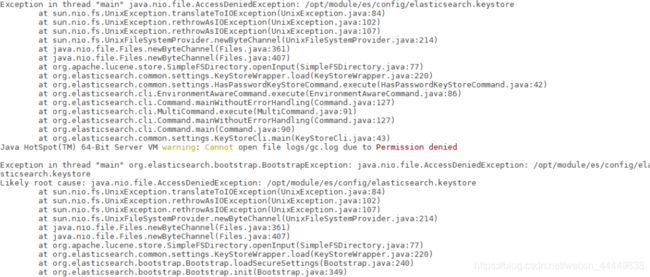- ES聚合分析原理与代码实例讲解
光剑书架上的书
大厂Offer收割机面试题简历程序员读书硅基计算碳基计算认知计算生物计算深度学习神经网络大数据AIGCAGILLMJavaPython架构设计Agent程序员实现财富自由
ES聚合分析原理与代码实例讲解1.背景介绍1.1问题的由来在大规模数据分析场景中,特别是在使用Elasticsearch(ES)进行数据存储和检索时,聚合分析成为了一个至关重要的功能。聚合分析允许用户对数据集进行细分和分组,以便深入探索数据的结构和模式。这在诸如实时监控、日志分析、业务洞察等领域具有广泛的应用。1.2研究现状目前,ES聚合分析已经成为现代大数据平台的核心组件之一。它支持多种类型的聚
- ElasticSearch查询超过10000条(1000页)时出现Result window is too large的问题
王月亮17
问题当ES数据量较大,使用分页查询超过10000条(1000页)时,出现如下错误:Cannotexecutejestaction,responsecode:500,error:{"root_cause":[{"type":"query_phase_execution_exception","reason":"Resultwindowistoolarge,from+sizemustbelesstha
- Elasticsearch7.7.0 配置用户名和密码
i0208
Elasticsearch
配置用户和密码需要在配置文件中开启x-pack验证,修改config目录下面的elasticsearch.yml文件,在里面添加如下内容,并重启ES[root@localhostesuser]#vim/opt/es/elasticsearch-7.7.0/config/elasticsearch.ymlxpack.security.enabled:truexpack.license.self_ge
- elasticsearch数据迁移之elasticdump
迷茫运维路
elasticsearch中间件elasticsearchlinux运维
系列文章目录第一章es集群搭建第二章es集群基本操作命令第三章es基于search-guard插件实现加密认证第四章es常用插件文章目录系列文章目录前言一、elasticdump是什么?二、安装elasticdump工具1.离线安装2.在线安装三、elasticdump相关参数四、使用elasticdump进行数据备份五、使用elasticdump进行数据恢复前言在企业实际生产环境中,避免不了要对
- 在生产环境中部署Elasticsearch:最佳实践和故障排除技巧——聚合与搜索(三)
不会编程的小孩子
elasticsearch大数据搜索引擎
#在生产环境中部署Elasticsearch:最佳实践和故障排除技巧——聚合与搜索(三)前言文章目录前言-聚合和分析-执行聚合操作-1.使用JavaAPI执行聚合操作-2.使用CURL命令执行聚合操作-1.使用JavaAPI执行度量操作-2.使用CURL命令执行度量操作-使用缓存-调整分片大小和数量-使用搜索建议-结论-节点发现-负载均衡-故障转移-结论-访问控制-加密-身份验证-结论-RESTA
- Elasticsearch Java API 的使用(22)—实现桶聚合
迷途码界
ElasticsearchJavaAPI桶聚合
分组聚合使用terms实现分组集合publicclassEsTermsAggthrowsUnknownHostException{publicvoidTermsAgg(TransportClientclient){AggregationBuilderagg=AggregationBuilders.terms("terms").field("agg");SearchResponseresponse=
- Elasticsearch之bool查询
cyt涛
javaelasticsearch大数据搜索引擎bool布尔查询全文检索
bool查询是Elasticsearch中最常用的复合查询类型,允许将多个查询组合在一起。它通过逻辑操作符(如must、should、must_not和filter)来构建复杂的查询条件,从而满足多条件匹配、逻辑与(AND)、或(OR)、非(NOT)的查询需求。bool查询主要由四个部分组成:must:必须满足的条件(类似于SQL中的AND)。should:应该匹配的条件(类似于SQL中的OR)。
- Elasticsearch 安装
哒哒-blog
Elasticsearchelasticsearchjenkins大数据
下载安装elasticsearch下载链接运行:bin\elasticsearch.bat设置密码:.\bin\elasticsearch-setup-passwordsinteractive这边设置密码遇到一个坑PSG:\elasticsearch-8.8.1>.\bin\elasticsearch-setup-passwordsinteractiveFailedtoauthenticateus
- Docker启动Elasticsearch(挂载数据、配置文件、插件)
程序员迪迦
项目实战Javaelasticsearchdocker
Docker启动Elasticsearch拉取镜像dockerpullelasticsearch:7.4.2修改配置文件mkdir-p/mydata/elasticsearch/configmkdir-p/mydata/elasticsearch/data/mkdir-p/mydata/elasticsearch/pluginsecho"http.host:0.0.0.0">>/mydata/el
- docker部署elasticsearch
大大陈·
elasticsearchdocker大数据
docker部署es1.简单启动2.配置文件3.安装es步骤1.简单启动#"discovery.type=single-node"标识单机启动dockerrun-d--nameelasticsearch-p9200:9200-p9300:9300-e"discovery.type=single-node"elasticsearch:tag#如果没有上面的标识,是集群启动,不这样做会报错#但是这样启
- Docker安装elasticsearch和kibana
viego1999
elasticsearchdocker大数据
1、首先拉取elasticsearch镜像dockerpullelasticsearch:7.9.12、创建docker挂载的目录我这里将docker环境下挂在的目录统一放在了/dockerdata目录下mkdir-p/dockerdata/elasticsearch/configmkdir-p/dockerdata/elasticsearch/datamkdir-p/dockerdata/ela
- Docker部署单点es
Javaismymorning
ES学习笔记dockerelasticsearch
前言该笔记是根据B站上黑马SpringCloud学习总结的一、ES是什么?Elasticsearch是一个分布式、高扩展、高实时的搜索与数据分析引擎。它能很方便的使大量数据具有搜索、分析和探索的能力。充分利用Elasticsearch的水平伸缩性,能使数据在生产环境变得更有价值二、Docker部署ES步骤1.创建网络因为还要部署Kibana,实现es和Kibana关联,创建一个网络Kibana是为
- MySQL同步数据到Elasticsearch
运维小雅
elasticsearchmysql大数据
背景随着平台的业务日益增多,基于数据库的全文搜索查询速度较慢,已经无法满足需求。所以,决定基于Elasticsearch做一个全文搜索平台,支持业务相关的搜索需求。那么第一个问题就是:如何从MySQL同步数据到Elasticsearch?解决方案一:基于Logstash同步数据该方案上次有详细说明过,这里就简单描述一下。Logstash同步数据流程图:优点:1、组件少,只需要Logstash就可以
- docker安装与使用
小鱼做了就会
开发框架及各种插件dockerjavamavenubuntulinux
docker安装与使用一、docker安装二、容器三、镜像五、Docker部署ES5.1部署ES5.2配置跨域5.3重启容器5.4Docker部署ES-IK分词器5.5Docker部署ElasticSearch-Head5.6Docker快速安装kibana一、docker安装sudowget-qO-https://get.docker.com/|bash二、容器容器是由镜像实例化而来,这和我们学
- ES(Elasticsearch)常用的函数
遨游在知识的海洋里无法自拔
java
Elasticsearch(简称ES)是一个开源的搜索引擎,广泛用于全文搜索、分析和数据可视化。以下是一些常用的Elasticsearch函数和操作:索引操作创建索引PUT/index_name删除索引DELETE/index_name查看索引GET/index_name文档操作插入文档POST/index_name/_doc/{"field":"value"}获取文档GET/index_name
- java实现es分页查询_elasticsearch high level rest api分页查询数据
weixin_42565971
java实现es分页查询
Transport方式查询数据,在今后的elasticsearch中将不在维护,官方推荐用用highlevelrestapi或者lowerlevelapi去操作elasticsearch中的数据。在elasticsearch的增删改查操作中,其实最复杂的也就是分页查询了,根据elasticsearch官方资料,做个简单的笔记.1.准备jar包,我用的elasticsearch7.3版本,各版本需要
- python连接es_Elasticsearch --- 3. ik中文分词器, python操作es
weixin_39962285
python连接es
一.IK中文分词器1.下载安装2.测试#显示结果{"tokens":[{"token":"上海","start_offset":0,"end_offset":2,"type":"CN_WORD","position":0},{"token":"自来水","start_offset":2,"end_offset":5,"type":"CN_WORD","position":1},{"token":"
- python 写入es_python-elasticsearch从创建索引到写入数据
夙砂酒
python写入es
创建索引fromelasticsearchimportElasticsearches=Elasticsearch('192.168.1.1:9200')mappings={"mappings":{"type_doc_test":{#type_doc_test为doc_type"properties":{"id":{"type":"long","index":"false"},"serial":{"
- 使用Python的Elasticsearch客户端 elasticsearch-py 来完成删除现有索引、重新创建索引并测试分词的示例代码
Roc-xb
Pythonpythonelasticsearch
以下是一个使用Python的Elasticsearch客户端elasticsearch-py来完成删除现有索引、重新创建索引并测试分词的示例代码一、安装依赖pipinstallelasticsearch二、运行效果三、程序代码fromelasticsearchimportElasticsearch,NotFoundError#连接到Elasticsearches=Elasticsearch(
- springboot指定依赖jar版本
m0_67402235
javajava后端
项目是maven父子项目结构如下:有多个子项目,因为springboot版本采用的是1.5.所以默认导入的elasticsearch版本是1.2.,而我们的集群是6.*的版本,试了很多次最后解决问题如下:在父pom的dependencyManagement中添加指定版本就可以了因为!!!父pom中指定版本优先级最高,所以可以解决子依赖pom中的版本问题。子模块只需要引入就可以了
- ElasticSearch-多边形范围查询(8.x)
W_Meng_H
#ElasticSearch#SpringBootelasticsearch大数据搜索引擎
目录一、字段设计二、数据录入三、查询语句四、Java代码实现开发版本详见:Elasticsearch-经纬度查询(8.x-半径查询)_es经纬度范围查询-CSDN博客一、字段设计PUT/aoi_points{"mappings":{"properties":{"location":{"type":"geo_shape"}}}}aoi_points是索引名称,location是字段名称,它将存储地理
- Elasticsearch文档值
知知之之
Elasticsearchelasticsearch大数据搜索引擎
在Elasticsearch中,文档值(DocValues)是用于高效存储和检索数据的一种数据结构,特别是在处理聚合、排序和过滤操作时。文档值是Elasticsearch为每个字段生成的预先计算的格式化数据,目的是改善性能和降低内存使用。什么是文档值(DocValues)文档值是将字段的数据存储在磁盘上的一种方式,使得字段的值以列式结构存储。这种存储方式使得对字段的高效检索和聚合成为可能,尤其是在
- 弹性搜索引擎Elasticsearch:本地部署与远程访问指南
猴哥是肖鸿
人工智能技术指导专升本jenkins运维
在大数据时代,数据搜索和分析成为企业核心竞争力的关键因素。弹性搜索引擎Elasticsearch作为一种分布式、可扩展的搜索和分析引擎,受到广泛欢迎。本文将介绍Elasticsearch的本地部署与远程访问,帮助读者更好地利用这一强大的工具。一、本地部署环境准备在开始部署Elasticsearch之前,需要准备以下环境:操作系统:Elasticsearch支持多种操作系统,如Linux、Windo
- elasticsearch
图灵农场
tl微服务专题
cluster:代表一个集群,集群中有多个节点,其中有一个为主节点,这个主节点是可以通过选举产生的,主从节点是对于集群内部来说的。es的一个概念就是去中心化,字面上理解就是无中心节点,这是对于集群外部来说的,因为从外部来看es集群,在逻辑上是个整体,你与任何一个节点的通信和与整个es集群通信是等价的。shards:代表索引分片,es可以把一个完整的索引分成多个分片,这样的好处是可以把一个大的索引拆
- ELK架构介绍
星河漫漫l
elkelasticsearch运维服务器
一、ELK简介ELK是由三个开源软件组成的,分别是:Elasticsearch、Logstash和Kibana,这三个软件各自在日志管理和数据分析领域发挥着重要作用。Elasticsearch提供分布式存储和搜索能力;Logstash负责数据收集和处理,而Kibana则提供数据可视化和分析界面。他们共同构成了一个完整的日志管理解决方案,帮助企业高效利用日志数据进行监控、分析和安全审计。1.Elas
- JAVA使用es不分词_谈谈 Elasticsearch 分词和自定义分词
weixin_39966376
JAVA使用es不分词
初次接触Elasticsearch的同学经常会遇到分词相关的难题,比如如下这些场景:1、为什么命名有包含搜索关键词的文档,但结果里面就没有相关文档呢?2、我存进去的文档到底被分成哪些词(term)了?3、我得自定义分词规则,但感觉好麻烦呢,无从下手如果你遇到过类似的问题,希望本文可以解决你的疑惑。一、上手让我们从一个实例出发,如下创建一个文档:PUTtest/doc/1{"msg":"Eating
- ElasticSearch 谈谈你对段合并的策略思想的认识
用心去追梦
elasticsearch大数据搜索引擎
段合并是Elasticsearch中的一个重要概念,它在数据索引和查询过程中起着关键的作用。Elasticsearch使用Lucene作为其全文搜索库,Lucene中使用的数据结构就是段(Segment)合并。段合并的策略思想主要体现在以下几个方面:提高查询性能:在Elasticsearch中,段合并的过程可以看作是对索引进行优化,通过合并将多个小的段合并成一个大的段,这样可以减少内存的使用,提高
- Grafana仪表盘设计最佳实践:如何创建有效的监控面板
范范0825
grafana信息可视化
Grafana仪表盘设计最佳实践:如何创建有效的监控面板引言Grafana是一个开源的数据可视化和监控平台,它提供了丰富的仪表盘功能,用于展示和分析各种数据源(如Prometheus、InfluxDB、Elasticsearch等)。有效的仪表盘设计能够帮助团队迅速识别和解决问题,提高系统的可靠性和性能。本文将深入探讨如何设计高效的Grafana仪表盘,涵盖最佳实践和实际应用。1.了解需求和目标1
- es安装ik分词器
abments
ESelasticsearchjenkins大数据
下载分词器首先确定es对应的版本(假设版本是7.10.0)根据版本下载指定的分词器开始安装在线安装./bin/elasticsearch-plugininstallhttps://github.com/medcl/elasticsearch-analysis-ik/releases/download/v7.10.0/elasticsearch-analysis-ik-7.10.0.zip离线安装-
- Elasticsearch——配置详解
smart哥
elasticsearch专题elasticsearch搜索引擎
作者简介:大家好,我是smart哥,前中兴通讯、美团架构师,现某互联网公司CTO联系qq:184480602,加我进群,大家一起学习,一起进步,一起对抗互联网寒冬学习必须往深处挖,挖的越深,基础越扎实!阶段1、深入多线程阶段2、深入多线程设计模式阶段3、深入juc源码解析阶段4、深入jdk其余源码解析阶段5、深入jvm源码解析码哥源码部分码哥讲源码-原理源码篇【2024年最新大厂关于线程池使用的场
- 二分查找排序算法
周凡杨
java二分查找排序算法折半
一:概念 二分查找又称
折半查找(
折半搜索/
二分搜索),优点是比较次数少,查找速度快,平均性能好;其缺点是要求待查表为有序表,且插入删除困难。因此,折半查找方法适用于不经常变动而 查找频繁的有序列表。首先,假设表中元素是按升序排列,将表中间位置记录的关键字与查找关键字比较,如果两者相等,则查找成功;否则利用中间位置记录将表 分成前、后两个子表,如果中间位置记录的关键字大于查找关键字,则进一步
- java中的BigDecimal
bijian1013
javaBigDecimal
在项目开发过程中出现精度丢失问题,查资料用BigDecimal解决,并发现如下这篇BigDecimal的解决问题的思路和方法很值得学习,特转载。
原文地址:http://blog.csdn.net/ugg/article/de
- Shell echo命令详解
daizj
echoshell
Shell echo命令
Shell 的 echo 指令与 PHP 的 echo 指令类似,都是用于字符串的输出。命令格式:
echo string
您可以使用echo实现更复杂的输出格式控制。 1.显示普通字符串:
echo "It is a test"
这里的双引号完全可以省略,以下命令与上面实例效果一致:
echo Itis a test 2.显示转义
- Oracle DBA 简单操作
周凡杨
oracle dba sql
--执行次数多的SQL
select sql_text,executions from (
select sql_text,executions from v$sqlarea order by executions desc
) where rownum<81;
&nb
- 画图重绘
朱辉辉33
游戏
我第一次接触重绘是编写五子棋小游戏的时候,因为游戏里的棋盘是用线绘制的,而这些东西并不在系统自带的重绘里,所以在移动窗体时,棋盘并不会重绘出来。所以我们要重写系统的重绘方法。
在重写系统重绘方法时,我们要注意一定要调用父类的重绘方法,即加上super.paint(g),因为如果不调用父类的重绘方式,重写后会把父类的重绘覆盖掉,而父类的重绘方法是绘制画布,这样就导致我们
- 线程之初体验
西蜀石兰
线程
一直觉得多线程是学Java的一个分水岭,懂多线程才算入门。
之前看《编程思想》的多线程章节,看的云里雾里,知道线程类有哪几个方法,却依旧不知道线程到底是什么?书上都写线程是进程的模块,共享线程的资源,可是这跟多线程编程有毛线的关系,呜呜。。。
线程其实也是用户自定义的任务,不要过多的强调线程的属性,而忽略了线程最基本的属性。
你可以在线程类的run()方法中定义自己的任务,就跟正常的Ja
- linux集群互相免登陆配置
林鹤霄
linux
配置ssh免登陆
1、生成秘钥和公钥 ssh-keygen -t rsa
2、提示让你输入,什么都不输,三次回车之后会在~下面的.ssh文件夹中多出两个文件id_rsa 和 id_rsa.pub
其中id_rsa为秘钥,id_rsa.pub为公钥,使用公钥加密的数据只有私钥才能对这些数据解密 c
- mysql : Lock wait timeout exceeded; try restarting transaction
aigo
mysql
原文:http://www.cnblogs.com/freeliver54/archive/2010/09/30/1839042.html
原因是你使用的InnoDB 表类型的时候,
默认参数:innodb_lock_wait_timeout设置锁等待的时间是50s,
因为有的锁等待超过了这个时间,所以抱错.
你可以把这个时间加长,或者优化存储
- Socket编程 基本的聊天实现。
alleni123
socket
public class Server
{
//用来存储所有连接上来的客户
private List<ServerThread> clients;
public static void main(String[] args)
{
Server s = new Server();
s.startServer(9988);
}
publi
- 多线程监听器事件模式(一个简单的例子)
百合不是茶
线程监听模式
多线程的事件监听器模式
监听器时间模式经常与多线程使用,在多线程中如何知道我的线程正在执行那什么内容,可以通过时间监听器模式得到
创建多线程的事件监听器模式 思路:
1, 创建线程并启动,在创建线程的位置设置一个标记
2,创建队
- spring InitializingBean接口
bijian1013
javaspring
spring的事务的TransactionTemplate,其源码如下:
public class TransactionTemplate extends DefaultTransactionDefinition implements TransactionOperations, InitializingBean{
...
}
TransactionTemplate继承了DefaultT
- Oracle中询表的权限被授予给了哪些用户
bijian1013
oracle数据库权限
Oracle查询表将权限赋给了哪些用户的SQL,以备查用。
select t.table_name as "表名",
t.grantee as "被授权的属组",
t.owner as "对象所在的属组"
- 【Struts2五】Struts2 参数传值
bit1129
struts2
Struts2中参数传值的3种情况
1.请求参数绑定到Action的实例字段上
2.Action将值传递到转发的视图上
3.Action将值传递到重定向的视图上
一、请求参数绑定到Action的实例字段上以及Action将值传递到转发的视图上
Struts可以自动将请求URL中的请求参数或者表单提交的参数绑定到Action定义的实例字段上,绑定的规则使用ognl表达式语言
- 【Kafka十四】关于auto.offset.reset[Q/A]
bit1129
kafka
I got serveral questions about auto.offset.reset. This configuration parameter governs how consumer read the message from Kafka when there is no initial offset in ZooKeeper or
- nginx gzip压缩配置
ronin47
nginx gzip 压缩范例
nginx gzip压缩配置 更多
0
nginx
gzip
配置
随着nginx的发展,越来越多的网站使用nginx,因此nginx的优化变得越来越重要,今天我们来看看nginx的gzip压缩到底是怎么压缩的呢?
gzip(GNU-ZIP)是一种压缩技术。经过gzip压缩后页面大小可以变为原来的30%甚至更小,这样,用
- java-13.输入一个单向链表,输出该链表中倒数第 k 个节点
bylijinnan
java
two cursors.
Make the first cursor go K steps first.
/*
* 第 13 题:题目:输入一个单向链表,输出该链表中倒数第 k 个节点
*/
public void displayKthItemsBackWard(ListNode head,int k){
ListNode p1=head,p2=head;
- Spring源码学习-JdbcTemplate queryForObject
bylijinnan
javaspring
JdbcTemplate中有两个可能会混淆的queryForObject方法:
1.
Object queryForObject(String sql, Object[] args, Class requiredType)
2.
Object queryForObject(String sql, Object[] args, RowMapper rowMapper)
第1个方法是只查
- [冰川时代]在冰川时代,我们需要什么样的技术?
comsci
技术
看美国那边的气候情况....我有个感觉...是不是要进入小冰期了?
那么在小冰期里面...我们的户外活动肯定会出现很多问题...在室内呆着的情况会非常多...怎么在室内呆着而不发闷...怎么用最低的电力保证室内的温度.....这都需要技术手段...
&nb
- js 获取浏览器型号
cuityang
js浏览器
根据浏览器获取iphone和apk的下载地址
<!DOCTYPE html>
<html>
<head>
<meta charset="utf-8" content="text/html"/>
<meta name=
- C# socks5详解 转
dalan_123
socketC#
http://www.cnblogs.com/zhujiechang/archive/2008/10/21/1316308.html 这里主要讲的是用.NET实现基于Socket5下面的代理协议进行客户端的通讯,Socket4的实现是类似的,注意的事,这里不是讲用C#实现一个代理服务器,因为实现一个代理服务器需要实现很多协议,头大,而且现在市面上有很多现成的代理服务器用,性能又好,
- 运维 Centos问题汇总
dcj3sjt126com
云主机
一、sh 脚本不执行的原因
sh脚本不执行的原因 只有2个
1.权限不够
2.sh脚本里路径没写完整。
二、解决You have new mail in /var/spool/mail/root
修改/usr/share/logwatch/default.conf/logwatch.conf配置文件
MailTo =
MailFrom
三、查询连接数
- Yii防注入攻击笔记
dcj3sjt126com
sqlWEB安全yii
网站表单有注入漏洞须对所有用户输入的内容进行个过滤和检查,可以使用正则表达式或者直接输入字符判断,大部分是只允许输入字母和数字的,其它字符度不允许;对于内容复杂表单的内容,应该对html和script的符号进行转义替换:尤其是<,>,',"",&这几个符号 这里有个转义对照表:
http://blog.csdn.net/xinzhu1990/articl
- MongoDB简介[一]
eksliang
mongodbMongoDB简介
MongoDB简介
转载请出自出处:http://eksliang.iteye.com/blog/2173288 1.1易于使用
MongoDB是一个面向文档的数据库,而不是关系型数据库。与关系型数据库相比,面向文档的数据库不再有行的概念,取而代之的是更为灵活的“文档”模型。
另外,不
- zookeeper windows 入门安装和测试
greemranqq
zookeeper安装分布式
一、序言
以下是我对zookeeper 的一些理解: zookeeper 作为一个服务注册信息存储的管理工具,好吧,这样说得很抽象,我们举个“栗子”。
栗子1号:
假设我是一家KTV的老板,我同时拥有5家KTV,我肯定得时刻监视
- Spring之使用事务缘由(2-注解实现)
ihuning
spring
Spring事务注解实现
1. 依赖包:
1.1 spring包:
spring-beans-4.0.0.RELEASE.jar
spring-context-4.0.0.
- iOS App Launch Option
啸笑天
option
iOS 程序启动时总会调用application:didFinishLaunchingWithOptions:,其中第二个参数launchOptions为NSDictionary类型的对象,里面存储有此程序启动的原因。
launchOptions中的可能键值见UIApplication Class Reference的Launch Options Keys节 。
1、若用户直接
- jdk与jre的区别(_)
macroli
javajvmjdk
简单的说JDK是面向开发人员使用的SDK,它提供了Java的开发环境和运行环境。SDK是Software Development Kit 一般指软件开发包,可以包括函数库、编译程序等。
JDK就是Java Development Kit JRE是Java Runtime Enviroment是指Java的运行环境,是面向Java程序的使用者,而不是开发者。 如果安装了JDK,会发同你
- Updates were rejected because the tip of your current branch is behind
qiaolevip
学习永无止境每天进步一点点众观千象git
$ git push joe prod-2295-1
To
[email protected]:joe.le/dr-frontend.git
! [rejected] prod-2295-1 -> prod-2295-1 (non-fast-forward)
error: failed to push some refs to '
[email protected]
- [一起学Hive]之十四-Hive的元数据表结构详解
superlxw1234
hivehive元数据结构
关键字:Hive元数据、Hive元数据表结构
之前在 “[一起学Hive]之一–Hive概述,Hive是什么”中介绍过,Hive自己维护了一套元数据,用户通过HQL查询时候,Hive首先需要结合元数据,将HQL翻译成MapReduce去执行。
本文介绍一下Hive元数据中重要的一些表结构及用途,以Hive0.13为例。
文章最后面,会以一个示例来全面了解一下,
- Spring 3.2.14,4.1.7,4.2.RC2发布
wiselyman
Spring 3
Spring 3.2.14、4.1.7及4.2.RC2于6月30日发布。
其中Spring 3.2.1是一个维护版本(维护周期到2016-12-31截止),后续会继续根据需求和bug发布维护版本。此时,Spring官方强烈建议升级Spring框架至4.1.7 或者将要发布的4.2 。
其中Spring 4.1.7主要包含这些更新内容。












